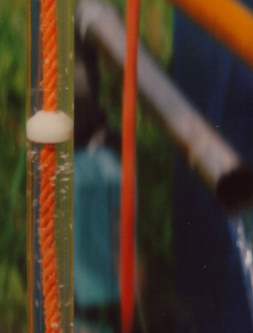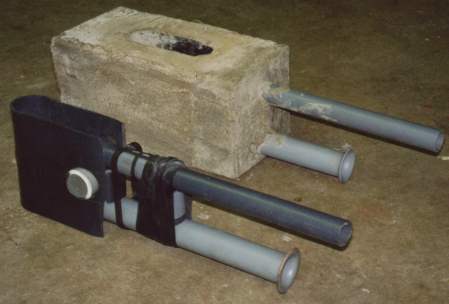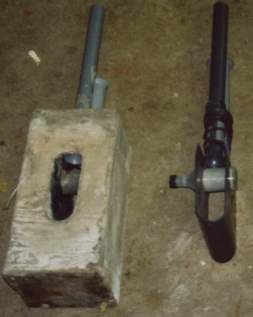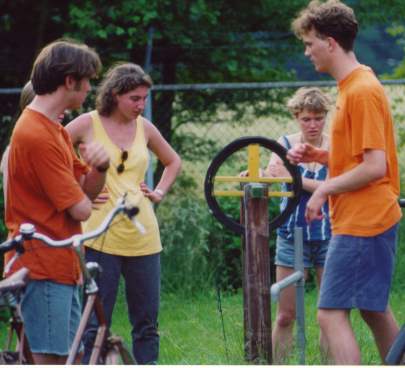Rope Water pump!
Made simpler every time you make one.

The WOT Rope pump with plastic discs in action.
Above a detail of the rope-pump, allowing a very low-cost installation for lifting water by hand or mechanical drive.
Main advantage of the rope-pump is the continuous pumping action so minimal force is needed to lift water. When applying mechanical drive, the continuous force is also optimal, in contrast to most valve-pumps. (The constant force results in less wear and higher efficiency) I will add better pictures soon, to show how to assemble the pump parts easily.
Most critical part of the pump is the bottom turning-point of the rope. The wear can be minimised by use of a ceramic or glass cilinder (small bottle or jar) and the disks should enter the lifting tube easily by flanging (widening) the bottom end.
Shown on the photos are two plastic/rubber fixtures of the PVC tubes, one already fixed into concrete. The thicker tube is used to guide the rope downward, the thinner one lifts water if the disks fit neatly inside. Note that one broken disk will not harm the pumping action, because a next disk will still lift the water. The number of disks is not critical, at least three are necessary but then the fit is very critical. More optimal is around 10 disks, also depending on the distance to lift the water. The disks should be at least half a meter apart.
At the top of the lifting tube, a widening and a T-joint are required to allow the water to be delivered smoothly. The rope can be driven by hand from a "wheel" which can be made from an old car type and four pieces of wood.
Cut the sides of the car tyre, resulting in circles approx 5 cm wide. Join the two sides by bolts & nuts or by driving nails through the two sides, approx 1 cm from the inner side. The part of the nails sticking out can be bent to lock the two tyre sides together in a circular V-shape. The rope can be run through the bottom of the V, where it is caught, so the pulling force of a spinning wheel will result in the rope being pulled through the tube, it should not result in the rope slipping between the tyres. The V-wheel can be caught on the middle of four pieces of wood as shown on the last photo. No attachment is needed, except a tight fit. The pieces of wood are screwed on a square axis, which can turn by locally (at two places) rounding it. These parts are caught between two metal slabs at the top of two poles. One slab is bent and entered into a hole of the pole, made with a saw. The second slab is put on top of the first slab and the wooden axis laying in the first slab.
Recently we made a bore-hole of only 8 cm (3 inches) wide, 7 meters deep and fitted a rope-pump on top. (Photos follow shortly)
Ordinary nylon rope can be used, but regular maintenance/replacement is needed when the rope shows wear due to frequent use. Disks can be made from rubber (the inner tube of a tyre or from the soft side of the outer tyre) but can also be made from plastic. We (the WOT) are developing a machine to automate the production of plastic discs. One of them is shown on the first photo.


The WOT rope pump explained

The bottom picture shows the wheel, the axis and the top of the delivery tube. The working principle and the construction is explained to development workers, who actually are assembling and erecting a pump during our yearly training week.
Shopping List:
Follows shortly....
Last update: February 24, 2000
Webmaster: Cor van de Water
DISCLAIMER:
The information on this page is presented in good faith of its usefulness and applicability, however no guarantees can be given that the information is correct and no responsibility is assumed in case the use of it results in damage. The applicant should treat the information with care, because it serves as illustration and description only.
The information is free of copyrights and fees (as far as we know) and can be used for private as well as commercial use. A notification of successful pump installation is appreciated.
The WOT has a history of working on rope pumps. We have construction manuals, contact addresses and specialists that helped setting up pump projects in e.g. Nicaragua.
Hotlinks:
WOT - Working group on Development Technology.
Wim Klunne's Micro Hydro pages
'All about pumps' calls the rope-pump: "Lift-disk pump"
Back to main (ram-pump) page
Email: Cor van de Water




